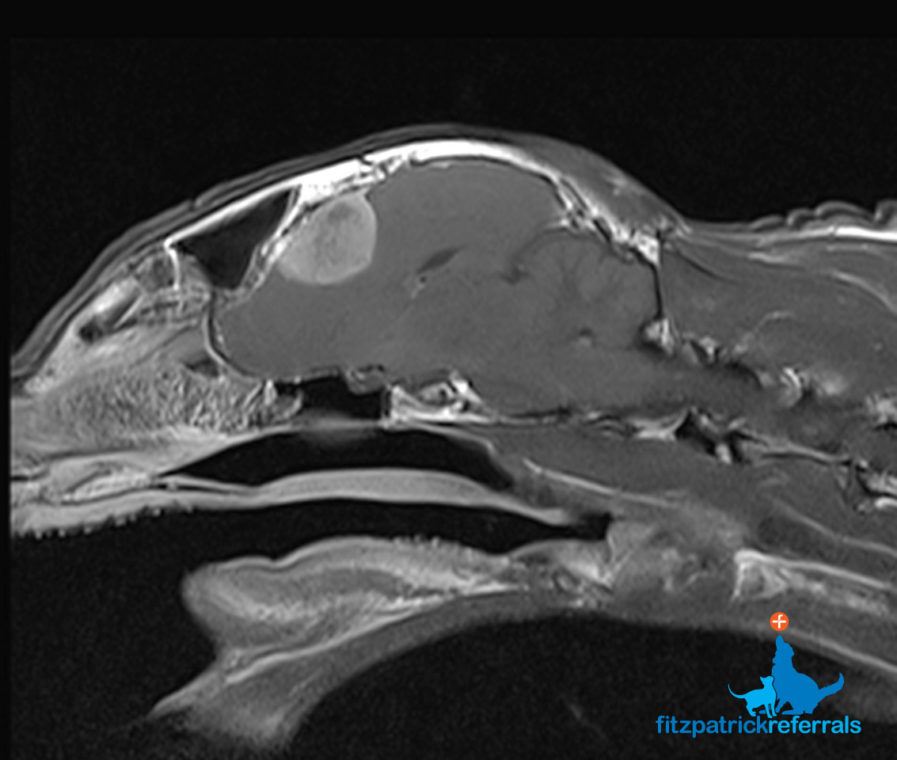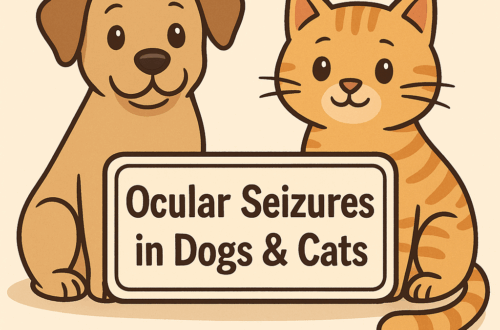Cats and dogs often develop neurologic abnormalities at home for which pet owners bring them to veterinarians for evaluation. Possible causes of neurologic deficits are varied but certainly include brain tumors. This week I’m sharing more information about brain tumors to provide more insight for pet owners. Happy reading!

Tell me more!
Brain tumors affect both cats and dogs. Usually when one hears the word tumor, they automatically (and understandably) think cancer, the dreaded “C” word. This is a valid fear. But, these tumors can be benign.
Brain tumors arise from one of three sources:
- Brain tissue – this is called a primary tumor
- Grow into the brain from nearby structures (e.g.: skull bones, nasal passages, ear tumors)
- Spread to the brain from another site – this is called a metastatic tumor
Any breed of cat and dog can develop tumors in the brain. Certain breeds (e.g.: domestic shorthair cats, Boston terriers, boxers, golden retrievers, Labrador retrievers, collies) are over-represented. Tumors are much more common in middle age and older patients (>5 years of age).
The most common type of primary tumor is called a meningioma. This tumor develops from the thin layer of tissue called the meninges that covers the brain and spinal cord. Sometimes primary tumors develop from deep within the brain tissue. These tumors are collectively called gliomas and are subsequently categorized as oligodendrogliomas and astrocytomas. Occasionally, primary tumors arise from ventricles, which are fluid-filled cavities in the brain; these tumors include ependymomas and choroid plexus tumors.
What do brain tumors look like?
Affected cats and dogs often have neurologic deficits. They can be quite varied, but usually develop slowly over weeks to months. Occasionally, clinical signs develop acutely (all of a sudden). Clinical signs depend on the size of a tumor and the specific structures affected by the tumor.
Common clinical signs include:
- Behavioral changes (e.g.: depression, aggression; star-gazing)
- Change in vision / vision loss
- Head pressing
- Seizures
- Gait changes (e.g.: ataxia/wobbliness)
- Lethargy
- Appetite changes

How are they diagnosed?
Determining the cause of a pet’s neurologic deficits is not always straightforward. Honestly, sometimes it can be quite challenging. For that reason, pet owners will likely find it uniquely helpful to partner with a board-certified veterinary neurologist to develop logical diagnostic plan.
Veterinarians will perform non-invasive testing to rule out diseases that can cause neurologic deficits. These tests include:
- Complete blood count
- Serum biochemical profile
- Urinalysis
- Blood pressure
- Infectious disease screening (depending on your geographic location)
- Testing for blood clotting abnormalities
Ultimately, advanced diagnostic imaging of the brain is needed to confirm the presence of a tumor. Imaging modalities include computed tomography (CT scan) and magnetic resonance imaging (MRI); the latter is the gold standard imaging modality for brain tissue. Computed tomography and MRI are not widely available in companion animal medicine. For that reason, pet owners are usually referred to a veterinary specialty hospital for this type of testing.

Performing MRI and CT scans requires the use of heavy sedation or general anesthesia. Unlike you and me, our pets will not sit perfectly still on the gantry table. During anesthesia, the veterinarian may recommend sampling cerebrospinal fluid (CSF; aka “spinal tap”) to rule out brain inflammation. It is important to note advanced diagnostic imaging may not provide a definitive diagnosis, and a brain biopsy may be needed to reach one.
How are they treated?
Treatment options for brain tumors include:
- Surgery – this is a viable option for tumors in certain parts of the brain (e.g.: meningiomas)
- Radiation therapy – this type of intervention can relieve clinical signs and is usually particularly helpful for those with inoperable tumors or those for whom a tumor could not be completely surgically removed
- Medication(s) – for example, drugs to control seizure activity and to reduce inflammation in brain tissue surrounding a tumor
The selected treatment(s) depend on a variety of factors, including a patient’s clinical signs, tumor size, and tumor location. A pet’s prognosis is predominantly affected by tumor type and location. Short-term prognosis for some tumors is favorable; for example, some cats meningiomas may live high quality lives for 2-3 years after surgery. However, long-term prognosis is always poor for cats and dogs.
The take-away message about brain tumors in cats & dogs…
Our cats and dogs may develop brain tumors. The tumors may be cancerous or benign, but both can cause meaningful neurologic deficits. Advanced diagnostic imaging is recommended to confirm presence and specific location. Potential therapies include surgery, radiation therapy, and/or medications.
To find a board-certified veterinary neurologist, please visit the American College of Veterinary Internal Medicine.
Wishing you wet-nosed kisses,
CriticalCareDVM




